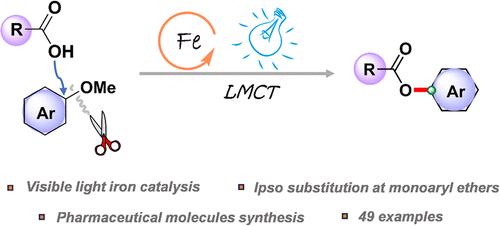Photoinduced Iron-Catalyzed Aryl Ester Synthesis via C(sp2)-O Cross-Coupling of Carboxylic Acids with Anisoles
IF 13.1
1区 化学
Q1 CHEMISTRY, PHYSICAL
引用次数: 0
Abstract
An efficient method for the synthesis of aryl esters was developed using photoinduced iron catalysis. The carboxylation of abundantly available anisoles proceeds via an aromatic radical substitution pathway. A broad range of carboxylic acids and anisoles were successfully coupled to afford aryl esters in moderate to good yields. Mechanistic studies revealed that (i) Fe(III) is reduced to Fe(II) along with the generation of a chloride radical through a visible-light-induced ligand-to-metal charge transfer (LMCT) process; (ii) the carboxy radical is formed via hydrogen atom transfer (HAT) from the carboxylic acid to the chloride radical; (iii) Fe(III) promotes ipso-substitution by interacting with the electronegative oxygen atom of the anisole to facilitate the aryl esters synthesis.

光诱导铁催化C(sp2)-O交叉偶联羧酸与茴香醚合成芳基酯
研究了光诱导铁催化合成芳基酯的有效方法。大量可用茴香醚的羧基化是通过芳基取代途径进行的。广泛的羧酸和茴香醚成功地偶联,以中等到良好的产量提供芳基酯。机理研究表明:(1)Fe(III)通过可见光诱导的配体-金属电荷转移(LMCT)过程被还原为Fe(II),同时生成氯自由基;(ii)羧基通过从羧酸到氯基的氢原子转移(HAT)形成;(iii) Fe(iii)通过与苯甲醚的电负性氧原子相互作用促进对映基取代,促进芳基酯的合成。
本文章由计算机程序翻译,如有差异,请以英文原文为准。
求助全文
约1分钟内获得全文
求助全文
来源期刊

ACS Catalysis
CHEMISTRY, PHYSICAL-
CiteScore
20.80
自引率
6.20%
发文量
1253
审稿时长
1.5 months
期刊介绍:
ACS Catalysis is an esteemed journal that publishes original research in the fields of heterogeneous catalysis, molecular catalysis, and biocatalysis. It offers broad coverage across diverse areas such as life sciences, organometallics and synthesis, photochemistry and electrochemistry, drug discovery and synthesis, materials science, environmental protection, polymer discovery and synthesis, and energy and fuels.
The scope of the journal is to showcase innovative work in various aspects of catalysis. This includes new reactions and novel synthetic approaches utilizing known catalysts, the discovery or modification of new catalysts, elucidation of catalytic mechanisms through cutting-edge investigations, practical enhancements of existing processes, as well as conceptual advances in the field. Contributions to ACS Catalysis can encompass both experimental and theoretical research focused on catalytic molecules, macromolecules, and materials that exhibit catalytic turnover.
 求助内容:
求助内容: 应助结果提醒方式:
应助结果提醒方式:


